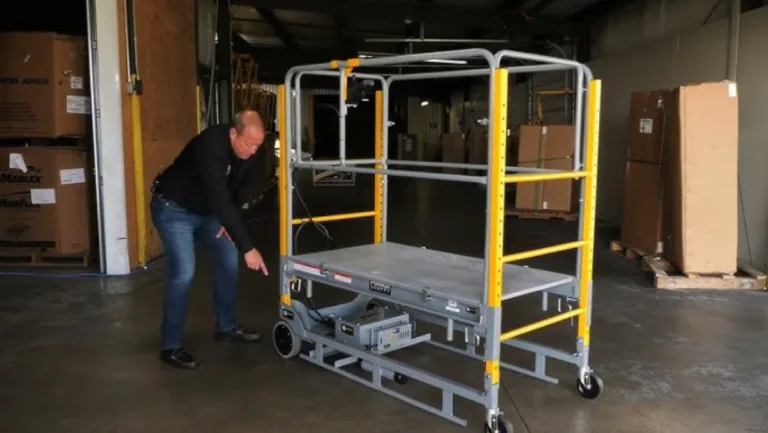Phone:
(+65)8319-0742
In the fast-paced world of construction, efficiency and safety are key. Scaffolding software has become a game-changer. It streamlines the scaffolding lifecycle, from requests to inventory management. This technology helps construction companies work better, stay safe, and be more productive.
Scaffolding software offers a complete solution for managing scaffolding operations. It supports customized workflows and safety checks. It also provides real-time analytics and reporting, helping leaders make smart decisions.
It keeps track of inspections and scaffold tags, ensuring safety standards are met. By using scaffolding software, companies can better use their resources. The software works on smart devices, making it easy for teams to communicate and work together, no matter where they are.
Key Takeaways
- Scaffolding software streamlines the entire scaffolding lifecycle, from requests to inventory management
- Customized workflows and safety validations ensure compliance and enhance site safety
- Real-time analytics, KPIs, and reporting enable informed decision-making
- Accessible on smart devices, the software optimizes manpower, materials, time, and productivity
- Scaffolding software is a crucial construction technology for the success of modern construction projects
Introduction to Scaffolding Software
Scaffolding software has changed the construction world. It makes managing scaffolding easier and safer. It’s used in all kinds of projects, big and small. With it, companies can keep track of their scaffolding and follow safety rules.
The idea of scaffolding started in software development. It was first used in Ruby on Rails to quickly make basic code. Now, other areas like construction use it to make and manage scaffolding faster.
Scaffolding software has many features to help manage scaffolding. It includes:
- Inventory management for tracking scaffolding components and materials
- Equipment tracking to monitor the location and status of scaffolding assets
- Work order management for efficient planning and execution of scaffolding tasks
- Inspection and maintenance scheduling to ensure scaffolding safety and compliance
Using scaffolding software makes construction work better. It gives real-time data, helps teams work together, and keeps projects on track. It also makes sure projects follow safety rules, like those for vaulted scaffolding.
Scaffolding software is key for construction firms to improve their scaffolding work and stay ahead.
More and more companies are using scaffolding software. It helps all kinds of construction projects, from small jobs to big ones. It offers solutions that fit each project’s needs.
| Feature | Benefit |
|---|---|
| Inventory Management | Efficient tracking and allocation of scaffolding components |
| Equipment Tracking | Real-time monitoring of scaffolding assets and their locations |
| Work Order Management | Streamlined planning and execution of scaffolding tasks |
| Inspection and Maintenance | Ensured safety and compliance through regular inspections and maintenance |
As construction keeps changing, scaffolding software will be more important. It will help make projects more efficient, safe, and profitable.
Benefits of Using Scaffolding Software
The construction industry has seen a big change with scaffolding software. It makes projects safer, more efficient, and cheaper. This software uses new tech and simple steps to help workers handle big projects better.
Improved Safety and Compliance
Safety is key in building things, and scaffolding software helps a lot. A survey showed most users felt safer after using this software. It helps spot dangers and bad setups early, cutting down on accidents.
Also, 3D models help make sites safer by showing all the details. This lets teams find and fix problems before they start. Apps like JT THORPE Safety from Patented Scaffolding Solutions focus on keeping workers safe.
Enhanced Efficiency and Productivity
Scaffolding software makes building projects go faster and better. The State of Scaffolding Technologies 2020 report says good contractors use design software. This software makes planning quicker and design changes easier.
Old ways of drawing scaffolds were slow and often wrong. But scaffolding software makes designing faster and more accurate. It also helps teams talk better and make decisions quicker. This means projects finish sooner and with less hassle.
Cost Savings and Resource Optimization
Using scaffolding software saves money and makes better use of resources. It helps keep track of materials and tools, so they’re used right when needed. This cuts down on waste and saves money.
It also helps design scaffolds better, using less material. This saves money and is better for the planet. Companies like Layher have software like LayPLAN that helps plan and manage scaffolding. This makes projects cheaper and more efficient.
Key Features of Scaffolding Software
Scaffolding software has important features that make construction projects run smoother. These features help manage resources better, follow safety rules, and work more efficiently.
Inventory Management
Managing inventory well is key for scaffolding companies to save money and use resources wisely. The software helps track materials and equipment in real-time. This way, companies can keep their stock levels right, see how much is used, and decide when to buy more.
Equipment Tracking
The software tracks scaffolding equipment on different projects. This ensures it’s used right, cuts downtime, and stops theft. It also helps plan for maintenance and repairs, making equipment last longer.
Work Order Management
Managing work orders is vital for scaffolding work. The software makes it easy to create, assign, and track work orders. This helps plan tasks, use resources well, and keep track of progress. It makes projects run faster, improves communication, and ensures quality work.
Inspection and Maintenance
Regular checks and maintenance of scaffolding equipment are crucial for safety and following rules. The software helps schedule and record inspections, track maintenance, and create reports. It helps spot problems early, prevents accidents, and keeps a safe work place.
| Feature | Benefits |
|---|---|
| Inventory Management | Optimize resources, reduce costs, maintain accurate stock levels |
| Equipment Tracking | Ensure optimal utilization, reduce downtime, prevent loss or theft |
| Work Order Management | Prioritize tasks, allocate resources effectively, monitor progress |
| Inspection and Maintenance | Ensure safety, maintain compliance, identify potential issues |
Using these key features of scaffolding software can greatly improve how a business works. It makes projects safer, more efficient, and successful. By combining inventory management, equipment tracking, work order management, and maintenance in one system, companies can work better, make smart choices, and stay ahead in the industry.
Integrating Scaffolding Software with BIM
Building information modeling (BIM) has changed the construction world. It works great with scaffolding software. This combo makes projects run smoother, safer, and more efficiently.
Popular BIM tools for scaffolding include Autodesk Revit, Trimble Tekla Structures, and Bentley Systems’ OpenBuildings Designer. These tools help designers make detailed 3D scaffolding models. This makes planning and coordination easier.
Using scaffolding software with BIM brings many benefits. For example:
- It makes visualization and clash detection better.
- It boosts accuracy and cuts down on mistakes.
- It makes teamwork among project members smoother.
- It automates the making of detailed drawings and documents.
- It helps use materials and equipment more wisely.
“Integrating our scaffolding software with BIM has been a game-changer for our projects. We’ve seen significant improvements in accuracy, efficiency, and collaboration across all stakeholders.” – Sarah Johnson, Project Manager at Scaffold Solutions Inc.
To link scaffolding design with BIM, you add scaffolding parts to the BIM software. This lets designers add these parts to their 3D models easily. It ensures the models are detailed and accurate.
| BIM Software | Key Features for Scaffolding Design |
|---|---|
| Autodesk Revit | – Extensive scaffolding component library – Automated clash detection – Detailed documentation generation |
| Trimble Tekla Structures | – Advanced 3D modeling capabilities – Customizable scaffolding components – Seamless integration with other software |
| Bentley Systems’ OpenBuildings Designer | – Comprehensive scaffolding design tools – Real-time collaboration features – Automated quantity takeoffs and estimating |
Using BIM and scaffolding software together helps construction pros a lot. It makes projects better, safer, and more efficient. As the construction world keeps changing, using these tools will be key to success.
Scaffolding Software and Risk Management
In the construction world, keeping workers safe and structures sound is key. Scaffolding software helps a lot with this by spotting unsafe structures and testing them virtually. Using this software, builders can lower risks and make projects safer.
One big plus of scaffolding software is finding unsafe structures early. It uses Building Information Modeling (BIM) to make detailed digital models of scaffolding. These models help check if the scaffolding meets safety rules, fixing problems before they start.
Identifying Non-Compliant Structures
Scaffolding software with BIM lets teams find unsafe structures through virtual tests. They input project details to get a digital scaffolding model. This model checks if the scaffolding is strong and safe.
The software spots problems like bad bracing or too much weight. Finding these issues early means builders can fix them before the scaffolding goes up. This makes the scaffolding safe and follows all safety rules.
Virtual Simulations for Safety Assessment
Scaffolding software also helps with safety checks through virtual tests. These tests let teams see how scaffolding works under different conditions. They can test it against wind, weight, and more.
These tests show weak spots and where extra support might be needed. This helps teams make the scaffolding safer and more stable. It also lowers the chance of accidents and delays.
Also, scaffolding management software tracks safety checks and upkeep. Keeping a digital record of these tasks helps keep the scaffolding safe. It also proves the company followed safety rules, protecting it from legal trouble.
Using scaffolding software in risk management has many benefits. It helps spot problems early, checks safety, and makes scaffolding better. This software is a smart investment for safer and more successful construction projects.
Choosing the Right Scaffolding Software
When picking scaffolding design software, think about what your business needs. Look at what different solutions offer and how they grow with your company. This way, you’ll find software that fits your goals and makes designing scaffolding easier.
Evaluating Business Needs
First, figure out what your company really needs. Think about the size of your projects, your team, and your budget. Decide which features are must-haves and which are nice extras. This helps you find the right software for your needs.
Comparing Features and Functionalities
After knowing what you need, compare different software options. Look for tools with easy-to-use 3D design, engineering tools, and the ability to make complex designs. Here are some popular choices:
- Scaffcalc: It’s easy to use and has lots of engineering features, popular in the Nordics.
- LayPLAN Classic: Great for Layher scaffolding, it gives accurate measurements and detailed material lists.
- Scaffmax: A SketchUp Pro plugin that makes scaffolding designs around objects, perfect for complex designs.
- NTI Scaffplanner: A BIM solution for Autodesk Revit, it makes material lists and load capacity calculations.
- Avontus Scaffold Design: It lets you design 3D scaffolding and has tools for complex designs, exportable to PDF or AutoCAD.
Assessing Scalability and Integration Capabilities
Your scaffolding design software should grow with your business. Check if it can handle bigger projects and more users. Also, see if it works well with other tools you use or will use, like BIM software or project management platforms. Good integration can make your work flow better and faster.
When choosing, remember all-in-one solutions might seem good but can be expensive and slow to set up. Specialized software like Avontus Designer and Avontus Quantify are tailored for scaffolding, leading to faster setup and better customer satisfaction. Companies in Western Australia and New Zealand have seen big improvements in accuracy, efficiency, and cost savings with Avontus software.
By carefully looking at your needs, comparing software, and checking scalability and integration, you can choose the best scaffolding software for your business. The right software should make your design work easier, safer, and more efficient, helping your company succeed.
Implementing Scaffolding Software
Adding scaffolding software to your workflow is key to making construction projects better and more efficient. It means fitting the new software into your current systems smoothly. This way, projects keep running without too much trouble.
Teaching your team how to use the new software is very important. Good training helps everyone get the most out of it. Also, moving data from old systems to the new one is crucial to keep everything running smoothly.
Creating new ways of working that match the software is also vital. Using scaffolding in software development makes teams work better together. It also helps in making sure the software meets business needs well.
Scaffolding saves time by automating code generation for applications, enabling developers to focus on enhancing the application’s functionality.
It’s wise to roll out the software in stages. This lets you test and tweak it before using it everywhere. Teamsparq says a good plan is key to getting the most out of the software.
When you’re setting up the software, think about how it will work with other tools. Working well with project management and inventory systems makes the software even more useful.
- Check how your current systems work
- Make a detailed plan for setting up the software
- Teach your team how to use it
- Move data from old systems to the new one
- Make new ways of working that fit the software
By following the right steps and getting help from experts like Scaffold Type, you can make your construction projects safer, more efficient, and cheaper.
| Implementation Phase | Key Considerations |
|---|---|
| Planning | Assess existing workflows, define goals, and develop a detailed implementation plan |
| Training | Provide comprehensive training to users on software features and functionalities |
| Data Migration | Migrate data from legacy systems to the new scaffolding software |
| Process Alignment | Establish new processes and workflows that align with the scaffolding software |
| Integration | Integrate the scaffolding software with other tools and systems used in the construction process |
Best Practices for Using Scaffolding Software
To get the most out of scaffolding software, it’s key to follow best practices. These ensure smooth adoption, accurate data management, and ongoing process improvement. By doing so, construction companies can unlock the software’s full potential and achieve top results.
Training and User Adoption
Training is a crucial step in successfully using scaffolding software. Investing in detailed training helps employees grasp the software’s features and workflows. This leads to better adoption and streamlines processes, boosting overall efficiency.
Regular Data Updates and Maintenance
Keeping the software’s data accurate and reliable is vital. This means updating inventory records, validating equipment info, and checking for errors. Regular maintenance ensures data is trustworthy, helping companies make informed decisions.
Continuous Improvement and Process Optimization
Scaffolding software offers insights for improving and optimizing processes. Analyzing data on equipment use and work order times helps spot inefficiencies. By using these insights, companies can standardize workflows and improve project outcomes, leading to higher profits.






















